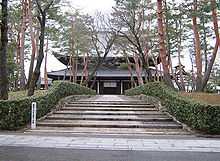Shōkoku-ji
| Shōkoku-ji 相国寺 | |
|---|---|
 | |
| Information | |
| Denomination | Rinzai |
| Founded | 1382 |
| Founder(s) |
Ashikaga Yoshimitsu Muso Soseki |
| Address | 701 Shokokuji Monzen-chō, Kamigyo-ku, Kyoto-shi, 602-0898 |
| Country | Kyoto, Japan |
| Website | http://www.shokoku-ji.or.jp http://www.shokoku-ji.or.jp |
Shōkoku-ji (相国寺), formally identified as Mannen-zan Shōkoku Shōten Zenji (萬年山相國承天禅寺), is a Buddhist temple in northern Kyoto, founded in 1382 by Ashikaga Yoshimitsu.
Buddhist center
In 1383, the Zen master Shun’oku Myōha (春屋妙葩) (1311–1388) was designated by Yoshimitsu as founding abbot,[1] however, Myōha insisted that the official honor be posthumously accorded to his own teacher, Musō Soseki.[2] The formal decision to grant this posthumous honor was proclaimed in 1385.[3]
Shōkoku-ji is considered to be one of the so-called Kyoto Gozan or "five great Zen temples of Kyoto". It was ranked the second of the Kyoto during the medieval period.[1] For a short time in 1392, Shōkoku-ji was considered first amongst the Gozan.[4]
Shōkoku-ji is one of fourteen autonomous branches of the Rinzai school of Japanese Zen. Today the temple is headquarters for the Shōkoku-ji branch of Rinzai Zen, with over ninety affiliated temples, including the famous Golden Pavilion and the Silver Pavilion temples in Kyoto.[2]
The Jotenkaku Museum is located in the premises of the temple.
History
Shōkoku-ji was founded in the middle Heian period.[5] Initial construction of the central temple structures was begun in 1383, and the entire temple complex was initially dedicated in 1392. In the eighth month of the third year of Meitoku, Yoshimitsu organized a great banquet attended by all the great officers of the Imperial court and the military leaders of that time. The pomp and ceremony of the affair was said to have equaled an Imperial event.[6]
The entire temple complex was destroyed by fire in 1394; but reconstruction financed by Yoshimitsu followed soon after. The temple complex has been rebuilt many times over the centuries, notably during the Onin War.[7]
After the Muromachi period, Shōkoku-ji was supported by several national leaders such as Toyotomi Hideyoshi, his son Toyotomi Hideyori, and Tokugawa Ieyasu, all of whom helped finance the temple’s various reconstruction projects.
- Hideyori financed the 1605 reconstruction of the Hatto (Dharma Hall); and this structure, designated as an Important Cultural Property, is presently the oldest building of its type in Japan.
- Ieyasu donated the Sanmon (Mountain Gate) in 1609.
- Emperor Go-Mizunoo donated an imperial palace building to serve as the Kaisando (Founder’s Hall).
Other buildings were reconstructed during this period, but, with the notable exception of the 17th century hatto, the temple complex was largely devastated during the conflagration of 1788.[2]
See also
- List of National Treasures of Japan (crafts-others)
- List of National Treasures of Japan (writings)
- Hōkō-ji, today a sub-temple
- List of Buddhist temples in Kyoto
- For an explanation of terms concerning Japanese Buddhism, Japanese Buddhist art, and Japanese Buddhist temple architecture, see the Glossary of Japanese Buddhism.
Notes
- ↑ 1.0 1.1 Titsingh, Isaac. (1834). Annales des empereurs du japon, p. 317.
- ↑ 2.0 2.1 2.2 Joint Council for Japanese Rinzai and Obaku Zen: Shōkoku-ji
- ↑ Titsingh, p. 317.
- ↑ Dumoulin, p. 174.
- ↑ Ponsonby-Fane, Richard. (1956). Kyoto: The Old Capital of Japan, 794-1869, p. 200.
- ↑ Titsingh, p. 320.
- ↑ Shōkoku-ji official web site: Fire and Reconstruction
References
- Baroni, Helen Josephine. (2002). The Illustrated Encyclopedia of Zen Buddhism. New York: Rosen Publishing Group. 10-ISBN 0-8239-2240-5; 13-ISBN 978-0-8239-2240-6; OCLC 42680558
- Dumoulin, Heinrich. (2005) Zen Buddhism: a History. Bloomington, Indiana: World Wisdom. 10-ISBN 0-941532-90-9; 13-ISBN 978-0-941532-90-7 (paper)
- Ponsonby-Fane, Richard Arthur Brabazon. (1956). Kyoto: The Old Capital of Japan, 794-1869. Kyoto: The Ponsonby Memorial Society.
- Titsingh, Isaac, ed. (1834). [Siyun-sai Rin-siyo/Hayashi Gahō, 1652], Nipon o daï itsi ran; ou, Annales des empereurs du Japon. Paris: Oriental Translation Fund of Great Britain and Ireland.
- Snyder, Gary. (1969). Earth House Hold: Technical Notes & Queries to Fellow Dharma Revolutionaries. New York :New Directions Publishing. 10-ISBN 0-8112-0195-3; 13-ISDBN 978-0-811-20195-7; OCLC 68655
External links
- Shōkoku-ji official web site
- Kyoto Prefectural Tourism Guide: Shōkoku-ji
- Joint Council for Japanese Rinzai and Obaku Zen: Shōkoku-ji
| ||||||||||||||||||||||||||||||||||||||||||||||||||||||||||||||||||||